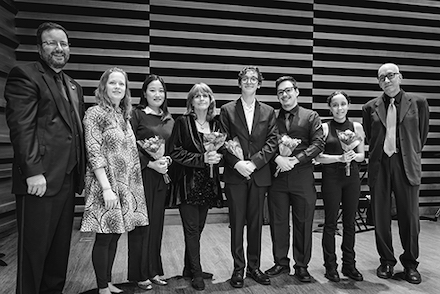By Sarah Sell, University Communications and Marketing
When Heather O’Leary started attending concerts held by USF’s School of Music in 2021, she loved how the performances made her feel.
As an anthropologist, she was moved and inspired by the ebb and flow of the music. She often wondered: could her own data touching on environmental impacts be turned into music that people could enjoy and understand?
“I was listening to all this beautiful music and thinking about my research and what I do every day,” said O’Leary, assistant professor of Anthropology at USF St. Petersburg. “I was thinking how sound could make my spreadsheets come alive. The challenge was making sense out of 50 columns of data that span over three years.”
Earlier this month, that challenge was met. O’Leary’s research data on the depletion of coral reefs due to Stony Coral Tissue Loss Disease and the impact of Harmful Algae Blooms on coastal economies was converted and performed as a piece of music by the university’s Symphonic Band & Wind Ensemble.
The collaboration began with the publication of a paper. O’Leary was part of a research team that found the red tide bloom in Florida from 2017-2019 cost tourism-related businesses an estimated $2.7 billion. The findings were significant, but the data was difficult to understand by non-experts.
Thinking back to the music, O’Leary loaded her spreadsheets into a sonification machine, which converted the data into sound. She thought it was exciting but not exactly what she was hoping for. So, she reached out to her colleague Matt McCutchen in USF’s College of the Arts.
“I thought it was a great idea and something that students would enjoy,” said McCutchen, associate professor of instruction and director of bands at USF Tampa. “The students are used to listening to music that does what they think it’s going to do, so this was like learning a new language.”

CRESCENDO group after Feb. 6 performance. Matthew McCutchen, Heather O'Leary, Grace Oh, Carrie Clarke, Huron Falkenburt, Hunter Pomeroy, Elis Jones and Paul Reller. Picture by student intern: Aiden Michael McKahan
McCutchen worked with Paul Reller, associate professor of composition, to find students who could help write the music.
This led to CRESCENDO, an interdisciplinary group of faculty and students working together to create and disseminate moving music about the environment. The acronym stands for Communicating Research Expansively through Sonification and Community-Engaged Neuroaesthetic Data-literacy Opportunities.
“It was real people sitting with real data, creating music,” McCutchen said. “If you listen to the piece, it’s not like any other piece you’ll listen to. There’s no real melody, the harmonies are different, and you don’t know where it’s going. But that’s the interesting and brilliant part behind it because scientific data is not pretty.”
The music is written in two parts: Sanctuary and Cardinal Flow. The piece combines three different data streams: environmental distress indicators, economic fallout and chatter on social media. O’Leary said these streams together give a broader picture of the true economic and social costs environmental threats have to our coasts.
Sanctuary is an acoustical sonification of Florida’s coral reefs under siege. It involves percussion instruments, giving it a broken and choppy sound. Cardinal Flow brings in the wind ensemble and presents moments of ups and downs, much like red tide does each year.
The music performed on Feb. 6 was part of the USF Symphonic Band & Wind Ensemble show at USF Concert Hall. It was filmed by students from USF’s Department of Communication, who plan to produce a music video featuring tourist destinations and a coral restoration lab. Students in USF’s Department of Education will also make an augmented reality experience out of the music and data.
“We can’t believe how much we are learning about the differences between our fields and similarities of the problems we face,” O’Leary said. “We all see messy data and have questions about how our research is affecting and impacting the public. What grabs my heart and holds it tight is that this type of interdisciplinary work is what a university is supposed to do.”